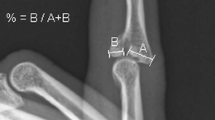Abstract
Kirschner wire (K-wire) fixation of fractures and dislocations of the hand and wrist is a common procedure. Of the 590 K-wire fixations performed on 236 patients, 36 (15.2%) experienced complications which included osteomyelitis, tendon rupture, nerve lesion, pin tract infection, pin loosening or migration. There were no deep soft-tissue pin infections or pyarthrosis. Technical failure, mainly when the procedure was performed by residents, and poor patient compliance were the major causes of complications. K-wire fixation is a simple but demanding procedure that cannot be left to an inexperienced resident. Elimination of technical failure, supervision in the operating room, close monitoring, prompt treatment upon discovery of a complication, and improvement of patient compliance can reduce the rate of complications.
Similar content being viewed by others
Author information
Authors and Affiliations
Additional information
Received: 30 October 2000
Rights and permissions
About this article
Cite this article
Stahl, S., Schwartz, O. Complications of K-wire fixation of fractures and dislocations in the hand and wrist. Arch Orth Traum Surg 121, 527–530 (2001). https://doi.org/10.1007/s004020100279
Issue Date:
DOI: https://doi.org/10.1007/s004020100279




